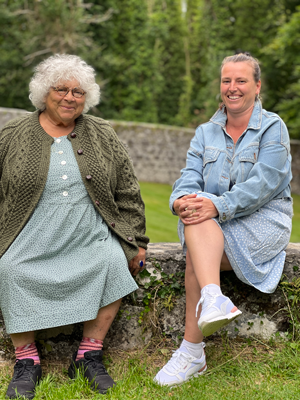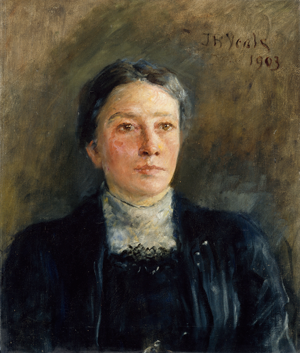LADY GREGORY: IRELAND’S FIRST SOCIAL INFLUENCER
Published in Issue 3 (May/June 2023), Reviews, Volume 31RTÉ1, 9 and 16 February 2023
By Sylvie Kleinman

Above: The programme’s two presenters, Miriam Margolyes and Senator Lynn Ruane, come across as committed and genuinely enthusiastic. (Kite Entertainment)
This deliberately unpretentious, occasionally rollicking yet robust and informative two-part documentary looks at the career and character of Lady Augusta Gregory (1852–1932), a leading figure in the Irish literary revival. A folklorist and Irish linguist who nurtured the talent of defining writers of the age—most notably W.B. Yeats, a personal friend and frequent guest at her Coole Park estate in County Galway—her name is forever linked to the founding of the Abbey Theatre. Overshadowed by others (male) whose creativity she had championed, her own writings, including no less than 44 plays, have fallen ‘out of fashion’.
The format interweaves personal and actual journeys, as the producers team up two ‘culture detectives’ from outside academia to present the programme. Clearly they were asked to make this somewhat mysterious figure in Irish cultural history ‘cool’, but the two women come across as committed and genuinely enthusiastic. Lynn Ruane, a Dublin University independent senator, writer and social activist from Tallaght, and the celebrated British ‘character’ actress Miriam Margolyes merrily bond not only with each other but with their subject, admitting that they are on a learning curve. To get closer to the real ‘Lady G’, as they put it, without the slightest hint of prejudice about this high-born daughter of Ascendancy landowners, they embark on a scenic road trip in a camper van well stocked with books.
To learn of Gregory’s privileged birth into the Persse family we began at their estate at Roxborough, Gort, Co. Galway, where only the shell of her birthplace, burnt down in 1922, remains. Considered ‘plain’ by harsh and unloving parents, and aware that her mother preferred her sons, she indulged her passion for books with her brothers’ help and had an affectionate nurse, Mary Sheridan. As Ruane observed, this relationship transcended the class divide, but an essential point was overlooked: that Sheridan was a Catholic and an Irish-speaker who told tales of 1798. When Augusta finally married at 27, she had acquired managerial skills from looking after Roxborough. Her husband, Sir William Gregory, a retired Irish MP and former governor of Ceylon, was 35 years older. A staunch conservative turned liberal, he was a patron of the arts who nurtured Augusta’s intellectual interests, introduced her into social circles and took her travelling.
Contrary to the image we have of her, she was a mixture of inner passion and outward decorum, with, as Margolyes put it, ‘a life below the waist’. In Egypt, aged 30, Augusta met and had a love affair with the dashing but married adventurer Wilfrid Scawen Blunt. The unrivalled scholar on Lady Gregory, James Pethica, at the former stables turned tea rooms at Coole Park, engagingly considered this seminal moment, which led her to re-evaluate her life as a wife, landowner and woman. In the 1970s, Blunt’s papers revealed that he had published sonnets under his name which she had written about their love, partially to process her guilt. Ruane read an extract from ‘A Woman’s Sonnets’, which conveyed Augusta’s troubled but eloquent feelings about passion and remorse.
As the chapter of her life with which we are more familiar began, empathy was snowballing. Widowed in 1892, she was in fact liberated socially, though burdened with keeping afloat Gregory’s estate at Coole, now a nature reserve. We saw the levelled outline of where the house once stood, where she had welcomed Hyde, Synge, Shaw, O’Casey and, obviously, Yeats, who purchased the nearby iconic Toor Ballylee. At her large and noble desk they had all worked. Pethica inherited it, but reassured viewers that it was promised to the Writers’ Museum in Dublin. In 1893 Lady Gregory travelled to the Aran Islands, worked on her Irish and began to collect folklore. In particular, she integrated the dialect from Kiltartan, near Coole, where her husband and brother built a national school. It now houses an enticing little museum brimming with Gregory–Yeats memorabilia. A major landmark was her publication in English of Cuchulain of Muirthemne in 1902.
The second episode took us back to Dublin via the Druid Theatre in Galway, which had staged some of Gregory’s plays during the pandemic and where Gary Hynes, a former director of the Abbey herself, conversed with the presenters. Recognising that Yeats was a great poet but also ‘parasitic and irritating’, the emphasis shifted back to Lady Gregory and her insistence on putting on Irish plays in Dublin and not London; her role in founding and helping to run the Abbey remains her most recognisable legacy. Her plays were put on there regularly in its early years, and even in its second building Margolyes was palpably moved to enter the ‘first state-supported national theatre in the English-speaking world’. We got some characteristically sharp views from Seán O’Casey and samples of his crackling dialogue, and a relaxed academic exploration of how and why Yeats’s name sold tickets on a bill more productively than Lady Gregory’s.
Hugh Lane was her nephew, and at the gallery Roy Foster, an expert on Yeats and his relationship with Gregory, was frank but pithy about what an annoying house guest at Coole the future Noble laureate had been. Is it fair that Yeats has so overshadowed her? Foster stressed that he is one of the great geniuses of world literary history, which Lady Gregory was not, but, prompted by Margolyes on a park bench, he was emphatic that Yeats would never have become what he had without her, and had duly acknowledged this in her lifetime.
While jokes and banter between the presenters, irrelevant to the main theme (and taking in tattoos and female body hair), may irritate snobs, the show was anything but highbrow. It failed to convincingly demonstrate that Lady Gregory was Ireland’s ‘first social influencer’ [emphasis added], as her achievements were in the arts. There are many examples of nineteenth-century women championing what we regard as ‘social’ causes. Nevertheless, the documentary certainly reignites interest in her from an open-minded and balanced ‘herstory’ perspective. It was visually entertaining, displayed key heritage sites and made Lady Gregory appealing to the general public.
Sylvie Kleinman is Visiting Research Fellow at the Department of History, Trinity College, Dublin.

















